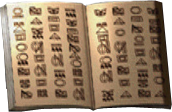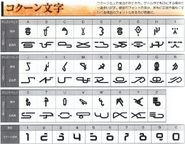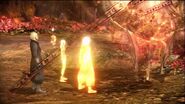Intangir Bot (talk | contribs) m (→Etro script: Relinking, replaced: Odin#Final Fantasy XIII → Odin (Final Fantasy XIII) (2)) |
Intangir Bot (talk | contribs) m (→''[[Final Fantasy XV]]'': Relinking, replaced: Great War of Old → War of the Astrals) |
||
| Line 132: | Line 132: | ||
When [[Noctis Lucis Caelum|Prince Noctis]] first hallucinates visions of [[Titan (Final Fantasy XV)|Titan]], he cannot understand the voice in his head. He confronts Titan at the [[Disc of Cauthess]], and through a vision learns [[Lunafreya Nox Fleuret]], the Oracle, wants him to forge covenants with the Astrals and thus they are calling to him. [[Shiva (Final Fantasy XV)|Gentiana]], a Messenger of the Astrals, guides him on his task. Lunafreya summons [[Leviathan (Final Fantasy XV)|Leviathan]] at [[Altissia]] and converses with her, but the sea goddess at first rejects a covenant with Noctis. She is killed during Leviathan's revelation, and mankind is left without means to speak directly to the gods. When Noctis meets [[Bahamut (Final Fantasy XV)|Bahamut]] he lands upon his palm, and when the god talks to him Noctis understands. Noctis perishes upon fulfilling the [[prophecy]] of the [[True King]]. |
When [[Noctis Lucis Caelum|Prince Noctis]] first hallucinates visions of [[Titan (Final Fantasy XV)|Titan]], he cannot understand the voice in his head. He confronts Titan at the [[Disc of Cauthess]], and through a vision learns [[Lunafreya Nox Fleuret]], the Oracle, wants him to forge covenants with the Astrals and thus they are calling to him. [[Shiva (Final Fantasy XV)|Gentiana]], a Messenger of the Astrals, guides him on his task. Lunafreya summons [[Leviathan (Final Fantasy XV)|Leviathan]] at [[Altissia]] and converses with her, but the sea goddess at first rejects a covenant with Noctis. She is killed during Leviathan's revelation, and mankind is left without means to speak directly to the gods. When Noctis meets [[Bahamut (Final Fantasy XV)|Bahamut]] he lands upon his palm, and when the god talks to him Noctis understands. Noctis perishes upon fulfilling the [[prophecy]] of the [[True King]]. |
||
| − | In the 1.00 version of the game, Bahamut spoke in the Astral language, but this was changed into the human language in the [[List of Final Fantasy XV patches|day one patch]]; the original scene would not make sense if the player had no subtitles on. When Noctis originally met [[Shiva (Final Fantasy XV)|Shiva]] she did not speak, but a scene was added in a patch that has Shiva tell Noctis the story of the [[ |
+ | In the 1.00 version of the game, Bahamut spoke in the Astral language, but this was changed into the human language in the [[List of Final Fantasy XV patches|day one patch]]; the original scene would not make sense if the player had no subtitles on. When Noctis originally met [[Shiva (Final Fantasy XV)|Shiva]] she did not speak, but a scene was added in a patch that has Shiva tell Noctis the story of the [[War of the Astrals]], and she uses the human language. In patch 1.21, Shiva's message to Ifrit—originally in the Astral language—was changed into the human language as well. This makes Bahamut and Shiva the only Astrals who are heard speaking the human language. In the original version it was implied Noctis now understood the Astral language, as he translated what she said to the others. In ''[[Final Fantasy XV: Comrades]]'' Bahamut speaks to the [[Kingsglaive (group)|Glaives]] in the human language as well. |
{{-}} |
{{-}} |
||
{{Endspoiler}} |
{{Endspoiler}} |
||
Revision as of 11:08, 21 March 2018
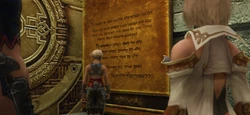
Ivalician script written on a wall in Final Fantasy XII.
A language is a system for the expression of thoughts, feelings, etc, by the use of spoken sounds or conventional symbols (such as alphabets). As is common in fiction, the usual language used in the Final Fantasy series reflects that of the audience of the game (i.e. in the Japanese versions, people speak Japanese; in the English versions, they speak English, etc.). However, other languages not usually understood by the main characters (at least initially) also appear.
Appearances
Final Fantasy
Template:Sideicon The Lufenian race speaks their own language, which is deciphered by the Warriors of Light after they bring the Rosetta Stone to Dr. Unne.
Final Fantasy II
Template:Sideicon The Beavers have their own language. Because Guy was raised in the wilderness, he speaks Beaver.
Final Fantasy V
Template:Sideicon It is said that animals, including chocobos, wind drakes and moogles, all have their own languages. Krile Mayer Baldesion possesses the unique ability to understand these animal speeches.
Final Fantasy VII
Template:Sideicon The Cetra have a unique writing system. Almost nothing is known about it, but it seems primarily pictographic rather than alphabetical. In the Forgotten Capital, Bugenhagen mentions there is writing on the altar, but says he cannot read it because he is not a Cetra.
Final Fantasy IX
Template:Sideicon
The language of Terra, with its unique script, appears in the game in locations of Terran origin, such as Oeilvert. Of the party members, only Zidane can decipher it.
Final Fantasy X and Final Fantasy X-2
Template:Sideicon Template:Sideicon
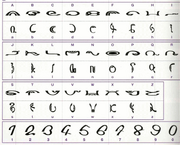
Spiran alphabet.
The world of Spira uses three different alphabets, which work like "codes" for the real world Latin alphabet. Most signs in the game are in Spiran alphabet, as is the writing in blitzball teams' logos, and the text ("nog") on Auron's keg. Tidus also has weapons with the text "Guardian" inscribed on them in Spiran script. The game backgrounds contain a fair share of writing, if one is willing to decipher their meaning. For example, right at the start of the game Tidus ends up in the ruins of Baaj temple, where the floors and walls have numerous inscriptions of words such as "Semour"[sic], "Jyscal Guado", "Fire", "Flower" and "Guadosalam".
Cactuars also have their own language with Benzo being the only human who knows that language.
Yevon
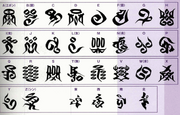
Yevon alphabet.
The Yevon script is related directly to Yu Yevon and the faith of Yevon. Examples can be seen in the temples, Bevelle and inside Sin. Its appearance is based on the Siddham Script used in Shingon Buddhism. Some of the symbols of the Yevon script alphabet have special meanings. A and Z represent Yevon and Sin and appear all over the game, sometimes paired, as on the The End screen . A and Z being the beginning and the end of the alphabet thus symbolize the beginning and end of all things. On the Spiran map
. A and Z being the beginning and the end of the alphabet thus symbolize the beginning and end of all things. On the Spiran map A representing Yevon is at the top, and Z representing Sin is at the bottom. The "A" sound is a central point of meditation for Shingon Buddhists, and the same sound in the Yevon script doubles as the glyph for Yevon itself.
A representing Yevon is at the top, and Z representing Sin is at the bottom. The "A" sound is a central point of meditation for Shingon Buddhists, and the same sound in the Yevon script doubles as the glyph for Yevon itself.
Other symbols exist that are associated with a particular aeon. The symbol for Valefor and Besaid Temple is annotated with the kanji for nothing (無, mu?). Emptiness, mu, is a Zen Buddhist concept expressing total negation of the self, selflessness, innocence and purity of soul. These are traits a summoner must achieve to succeed in defeating Sin. Buddhist concept of nothingness may also be associated with the element of air. Valefor is a flying aeon whose main attack is non-elemental and delays the opponent's turn, traits that also fit this theme.
The symbol for Ifrit and Kilika Temple is annotated with the kanji for flame (炎, honoo?). Sandy of the Magus Sisters also has a flame glyph on her summoning symbol. The symbol for Ixion and Djose Temple is annotated with the kanji for thunder (雷, kaminari?). Mindy of the Magus Sisters also has a lightning glyph on her summoning symbol. The symbol for Shiva and Macalania Temple is annotated with the kanji for ice (氷, koori?). The symbol for Bahamut and Bevelle is annotated with the kanji for light (光, hikari?). The Anima and Baaj symbol is annotated with the kanji for darkness (闇, yami?). The symbol for Cindy of Magus Sisters and the Remiem Temple is annotated with the kanji symbol for water (水, mizu?).
The elemental symbols also appear in Seymour's elemental reels in his various boss forms.
The Yevon glyphs marked with the kanji for the "Four Winds," i.e. directions, appear on the mandala activated by glyph spheres in the Cloister of Trials and the directional platforms in the Via Purifico, in the Cavern of the Stolen Fayth, and on Mt. Gagazet.
Officials of the Yevon Temples wear a band down the front of their robes with six special glyphs. The six signs also appear on Yevon tapestries, the sleeves of Seymour's wedding suit, and the map of Spira.
Al Bhed
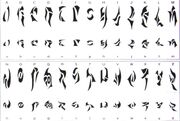
Al Bhed alphabet.
Al Bhed speak their own language. Working like a substitution cipher (a language system replacing certain letters with others), it shares the same syntax and grammar of English in the English version. In the Japanese version it follows much the same pattern except in using the Japanese romaji alphabet instead to speak and translate the language. It uses its own alphabet.
Final Fantasy XI
Template:Sideicon Since the servers of the game are worldwide, players from all regions in the world all play in the same environments, and so players can meet people using virtually any real world language in the game. However, the NPCs in the game all use the usual common language that reflects each player's language.
Final Fantasy XII
Template:Sideicon

Ivalician script.
The common language that reflects the player's language has its own alphabet, called "Ivalician script". Each region has its own accent. Additionally, several other languages, not used by the humes, are also alluded to. The denizens of the Skycity of Bhujerba have unique words among the humes.
The Ivalician script can be seen written on the boards in aerodromes, Gurdy's chocobo stable signs, the tavern menu in Sandsea bar in Royal City of Rabanastre, banners in Lowtown , and in summon glyphs that appear on the ground and air when an Esper is summoned or uses a special attack, among other places.
, and in summon glyphs that appear on the ground and air when an Esper is summoned or uses a special attack, among other places.
Fabula Nova Crystallis: Final Fantasy
Template:Sideicon
The language of the human race has changed little since ancient times. Records show that the tongue spoken by the people of Paddra almost a thousand years ago is functionally identical to that used by the present citizens of Academia. Although the language is much the same, it seems strange that the alphabets of Gran Pulse and Cocoon should vary so widely. Perhaps this variation stems from the fact that human language was not a naturally occurring phenomenon, but a tool given to us by the fal'Cie.
Academy Datafile, Final Fantasy XIII-2
Cocoon and Pulse writing
The scripts used by the civilizations of both Cocoon and Gran Pulse are stylized versions of their Latin counterparts. Most of the letters and numerals can be deciphered easily.
On Cocoon, the writing can be seen on numerous billboards, signs and buildings. In Final Fantasy XIII-2, the Cocoon writing is present in the town of New Bodhum, such as on a sign that reads "Serah's Room".
The Pulse writing is rarer, but is present on Lightning's and Fang's default weapons, and on old signs in Gran Pulse, as well as in the recording Vanille reads to the party in Oerba. Words written in Pulse writing are is also seen in the scene where the party is branded l'Cie, although these don't form any intelligible message, but merely spell words like "variable" and "multiplication".
In Final Fantasy Type-0, Pulse writing is seen on the world map of Orience. In an early Final Fantasy Versus XIII trailer, writing similar to the Pulse writing appears around a crest behind Stella Nox Fleuret when she summons her rapier .
.
Etro script
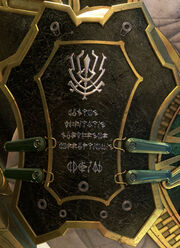
Script on Odin.
Etro script is inscribed on the Eidolons in Final Fantasy XIII. Like the other two scripts, it is reasonably easy to decipher some of it. Its origin is linked to the Goddess Etro. The writing can be seen on the Eidolons' bodies, as well on the summoning symbols that appear on the ground or air when a character calls forth their Eidolon. The Eidolons' script is in Latin.
E.g. the Latin writing on the symbol that emerges from the ground when Lightning summons Odin reads:
- Etro praedicatus, tonitrus tuum adventum annuntiet. Eveni, disparator factorum falsorunt.
- By grace of Etro, let thunder herald your arrival. Come forth, sunderer of falsehood.
- Nomen in sanguine et pactum in veritate est. Odin et suum coniunctum eternum et inexorabilium se leventur.
- A name in blood, a pact of truth. Odin shall rise his bond eternal and unyielding.
In Final Fantasy XIII-2, the Etro script is seen on the blades of Serah's weapon, the symbol on both her dress and Lightning's shield, as well as in the paradox effect. Writing in Etro script is also on Noel's dagger and the back of his shirt, as well as Caius's armor. When a Time Gate is activated, writing in Etro script is seen circling the gate. Etro's script is also seen around the minimap when traversing on the field, and around the introductory banners for DLC battles in the Coliseum. Writing similar to Etro's script appear in the Hands of Time Temporal Rift puzzles.
E.g.: the Latin writing on Serah's weapon reads:
- Longe Lateque Aetatum Lumen Illustrans Verum.
- Light ages far and wide, illustrating the truth.
In Lightning Returns: Final Fantasy XIII, Etro script acts as the language of the Children of Etro, a sect worshiping the goddess in defiance of the Order of Salvation, the chief faith in honor of Bhunivelze. A piece of readable Etro script is seen during the cutscene when Lightning arrives in Luxerion: writing appears on the beneath the station clock reading "The Liberator shall suffer death at the hands of the Dark Hunter". This same writing is also seen in Noel's lair in the Warren. In the English localization, the writing remains the same despite the alteration of the terms in dialogue ("Liberator" being "Savior" and "Dark Hunter" to "Shadow Hunter").
Curiously, the world of Nova Chrysalia uses neither Cocoon or Gran Pulse script, instead using regular English writing. This may be because the signs have more of an utility in guiding the player, rather than just being a background element, so they have been made easy to read.
The playing cards that appear as background elements in Final Fantasy XV have their numbers in Etro script. This is because they are reused assets from the Serendipity card games from Final Fantasy XIII-2.
Final Fantasy XIV
Template:Sideicon

Eorzean writing.
Eorzea has its own script, corresponding directly to, and with many letters resembling the Latin alphabet. It appears most notably on maps and inscribed in some pieces of equipment such as the Astaroth Cane. The Ascians have their own language, though they also speak the common Eorzean language.
Final Fantasy XV
Template:Sideicon The Astrals speak a language that can only be understood by those touched by the gods.[1] The Oracles had been gifted the ability to commune with the gods in antiquity, and can use the power to make mankind's wish known to the gods. The gods rarely appear in the mortal realm, but instead send forth Messengers.

Lunafreya, the Oracle, speaks with the Astral goddess Leviathan.
When Prince Noctis first hallucinates visions of Titan, he cannot understand the voice in his head. He confronts Titan at the Disc of Cauthess, and through a vision learns Lunafreya Nox Fleuret, the Oracle, wants him to forge covenants with the Astrals and thus they are calling to him. Gentiana, a Messenger of the Astrals, guides him on his task. Lunafreya summons Leviathan at Altissia and converses with her, but the sea goddess at first rejects a covenant with Noctis. She is killed during Leviathan's revelation, and mankind is left without means to speak directly to the gods. When Noctis meets Bahamut he lands upon his palm, and when the god talks to him Noctis understands. Noctis perishes upon fulfilling the prophecy of the True King.
In the 1.00 version of the game, Bahamut spoke in the Astral language, but this was changed into the human language in the day one patch; the original scene would not make sense if the player had no subtitles on. When Noctis originally met Shiva she did not speak, but a scene was added in a patch that has Shiva tell Noctis the story of the War of the Astrals, and she uses the human language. In patch 1.21, Shiva's message to Ifrit—originally in the Astral language—was changed into the human language as well. This makes Bahamut and Shiva the only Astrals who are heard speaking the human language. In the original version it was implied Noctis now understood the Astral language, as he translated what she said to the others. In Final Fantasy XV: Comrades Bahamut speaks to the Glaives in the human language as well.
Final Fantasy Tactics
Template:Sideicon The common language in that game uses a variant of the Ivalician script as in Final Fantasy XII. In addition, the Scriptures of Germonique is written in an ancient language called the Ikoku language, presumably used in Ajora's era. Since the game did not have an Ultimania, this language went unnoticed for years until a fan deciphered it on his own (see this archived link).
Final Fantasy Type-0
Template:Sideicon Though most of Orience speaks one language, Concordians command wyverns in Soryusian. While the common language of Orience boasts a superior vocabulary and ease of expression, Soryusian is an intentionally simple language. By limiting the number of phrases, dragoniers and other Concordians can communicate orders to dragons with little room for misunderstandings.
Final Fantasy Legend III
Template:Sideicon The WaterHag and Dwelg have their own language, and if the player attempt to talk to them. They will attack the party. The only way to understand their language is for the player to use the Morph spell and become a WaterHag or Dwelg.
Vagrant Story
Template:Sideicon A Kildean script is featured as an ancient script from Müllenkamp's era.
Trivia
- Several games in the series feature both Japanese and English writings in their worlds, even though these are generally treated as if they were all part of the same intelligible language by the characters.
References
- ↑ Final Fantasy XV Scenario Ultimania Translation Project — Mythos (Accessed: UnknownError: See this for how to archive.) at Medium
Template:Recurring elements


